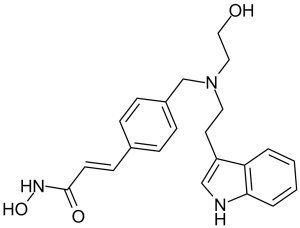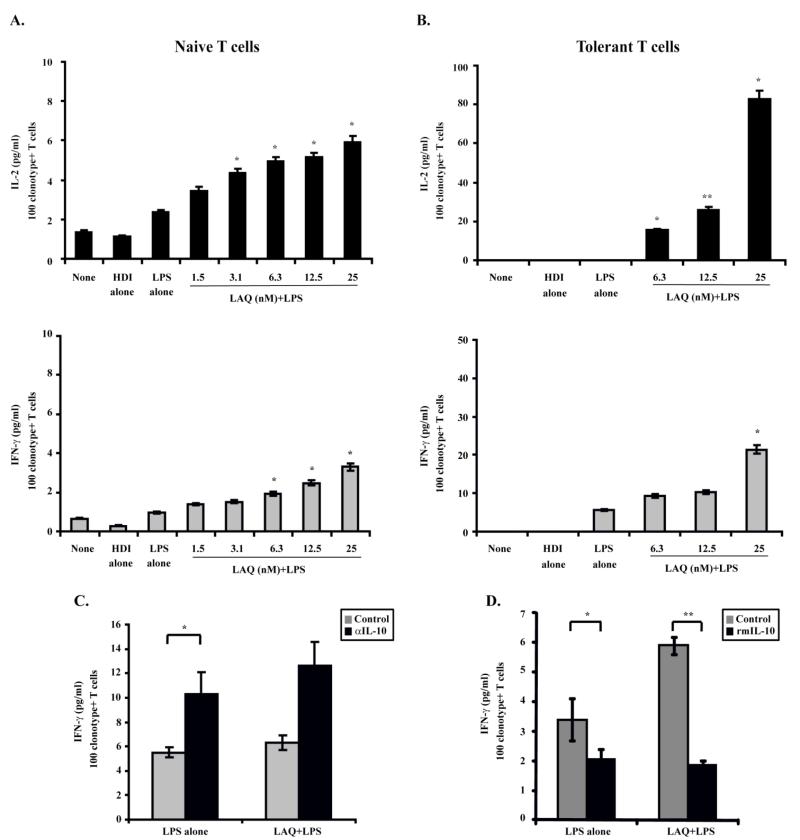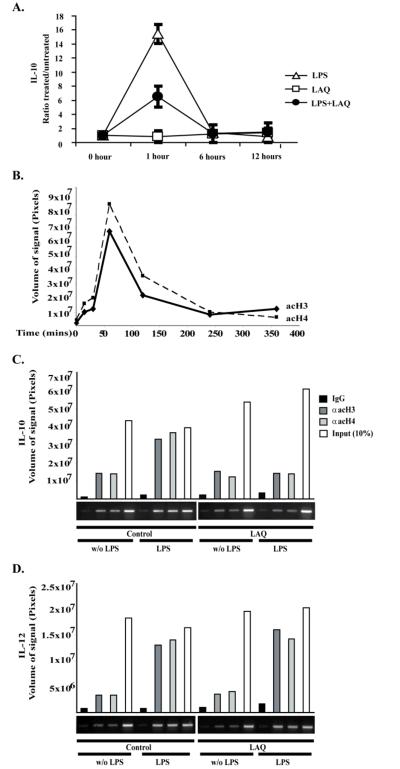This product is for research use only, not for human use. We do not sell to patients.

| Size | Price | Stock |
|---|---|---|
| 5mg | $90 | 3-6 Days |
| 25mg | $165 | 3-6 Days |
| 50mg | $250 | 3-6 Days |
| 100mg | $450 | 3-6 Days |
| 250mg | $900 | 3-6 Days |
| 500mg | $1550 | 3-6 Days |
Cat #: V0280 CAS #: 404951-53-7 Purity ≥ 98%
Description: Dacinostat (formerly LAQ824; NVP-LAQ824) is a novel, potent and hydroxamate-based inhibitor of histone deacetylase (HDAC) with potential anticancer activity. It inhibits HDAC with an IC50 of 32 nM; It shows potent anti-proliferative activity in vitro against various cancer cell lines such as H23 and H460 cell lines.
Publications Citing InvivoChem Products
Product Promise

- Physicochemical and Storage Information
- Protocol
- Related Biological Data
- Stock Solution Preparation
- Quality Control Documentation
| Molecular Weight (MW) | 379.46 |
|---|---|
| Molecular Formula | C22H25N3O3 |
| CAS No. | 404951-53-7 |
| Storage | -20℃ for 3 years in powder form |
| -80℃ for 2 years in solvent | |
| Solubility In Vitro | DMSO: 76 mg/mL (200.3 mM) |
| Water: <1 mg/mL | |
| Ethanol: <1 mg/mL | |
| Solubility In Vivo | 1% DMSO+30% polyethylene glycol+1% Tween 80: 30mg/mL |
| Synonyms | NVP-LAQ824; NVP-LAQ-824; NVP LAQ824; LAQ 824; LAQ824; LAQ-824; Dacinostat Chemical Name: (2E)-N-hydroxy-3-[4-[[(2-hydroxyethyl)[2-(1H-indol-3-yl)ethyl]amino]methyl]phenyl]-2-propenamide InChi Key: BWDQBBCUWLSASG-MDZDMXLPSA-N InChi Code: InChI=1S/C22H25N3O3/c26-14-13-25(12-11-19-15-23-21-4-2-1-3-20(19)21)16-18-7-5-17(6-8-18)9-10-22(27)24-28/h1-10,15,23,26,28H,11-14,16H2,(H,24,27)/b10-9+ SMILES Code: O=C(NO)/C=C/C1=CC=C(CN(CCO)CCC2=CNC3=C2C=CC=C3)C=C1 |
| Protocol | In Vitro | In vitro activity: LAQ824 activates the expression of the gene encoding the p21 cell cycle inhibitor by activating the p21 promoter with 50% of the maximal promoter activation (AC50) of 0.30 μM. LAQ824 inhibits the cell growth of both H1299, a non-small cell lung carcinoma line, and HCT116, a colon cancer cell line with IC50 of 0.15 μM and 0.01 μM, respectively, and the antiproliferative effect of LAQ824 is selective toward the tumor cell lines while inducing only growth arrest in normal fibroblasts. Furthermore, LAQ824 induces a dose-dependent increase of p21 protein in A549 cells and an increase in the hypophosphorylated state of the Rb tumor suppressor. A recent study shows that LAQ824 induces chromatin changes at the level of the IL-10 gene promoter that lead to enhanced recruitment of the transcriptional repressors HDAC11 and PU.1 and inhibits IL-10 production in BALB/c murine macrophages. Kinase Assay: HDAC enzymes are partially purified from H1299 cell lysate by ion exchange chromatography using the Q Sepharose Fast Flow column. Enzyme complexes are collected from 500 mg of total cell lysate by immunoprecipitation with cdk2 polyclonal antibody or cdk1/cdc2 monoclonal antibody. Immunoprecipitates are resuspended in kinase buffer (50 mM Hepes, pH 8, 10 mM MgCl2, 2.5 mM EDTA, 1 mM dithiothreitol, 20 mM ATP, 10 mM β-glycerophosphate, 0.1 mM NaVO4, 1 mM sodium fluoride, 50 mM ATP, 10 μCi of [γ-32P]ATP) along with 1 μg of pRb recombinant protein substrate (cdk2) or 10 mL of H1 histone mixture containing 20 μg of substrate (cdc2). Phosphorylated Rb and H1 histone are resolved by electrophoresis and quantitated using a PhosphorImager. Cell Assay: Cell proliferation is measured using an adaptation of published procedures (3-(4,5-dimethylthiazol-2-yl)-5-(3-carboxymethoxy-phenyl)-2-(4-sulfonyl)-2H-tetrazolium assay). The cells are seeded in 12-well dishes and cultured in RPMI 1640 containing 10% FBS. The cells are cultured in the presence of various concentrations of TSA (up to 1,000 ng/mL). To examine the growth inhibition by TSA, viable cell numbers are determined by trypan blue dye exclusion, counted in a Nesbauer-type hemocytometer for 0 hour, 24 hours, and 48 hours. The same amount of ethanol is added to the RPMI 1640 medium as the control experiment. All experiments are performed in duplicate and repeated 3 times The average background value (treatment with medium alone) is subtracted from each experimental well; triplicate values are averaged for each compound dilution. The following formulas are used to calculate the percentage of growth: If XT0, %Growth=(X-T0)/(GC-T0)*100. where T0 is the average value of T0 − background, GC is the average value of untreated cells (in triplicate) − background, and X is the average value of compound-treated cells (in triplicate)-background. The “% Growth” is plotted against compound concentration and used to calculate the IC50 using the linear regression techniques between data points to predict the concentration of compounds at 50% inhibition. |
|---|---|---|
| In Vivo | In HCT116 and human colon tumor xenografts in nude mice, LAQ824 treatment at 100 mg/kg produces the inhibitory effects on tumor growth in a dose-dependent mode without general cytotoxicity. | |
| Animal model | HCT116 cells is injected s.c. into the right axillary (lateral) region of outbred athymic (nu/nu) female mice. |
| Solvent volume to be added | Mass (the weight of a compound) | |||
|---|---|---|---|---|
| Mother liquor concentration | 1mg | 5mg | 10mg | 20mg |
| 1mM | 2.6353 mL | 13.1766 mL | 26.3532 mL | 52.7065 mL |
| 5mM | 0.5271 mL | 2.6353 mL | 5.2706 mL | 10.5413 mL |
| 10mM | 0.2635 mL | 1.3177 mL | 2.6353 mL | 5.2706 mL |
| 20mM | 0.1318 mL | 0.6588 mL | 1.3177 mL | 2.6353 mL |
This equation is commonly abbreviated as: C1 V1 = C2 V2
- (1) Please be sure that the solution is clear before the addition of next solvent. Dissolution methods like vortex, ultrasound or warming and heat may be used to aid dissolving.
- (2) Be sure to add the solvent(s) in order.







































